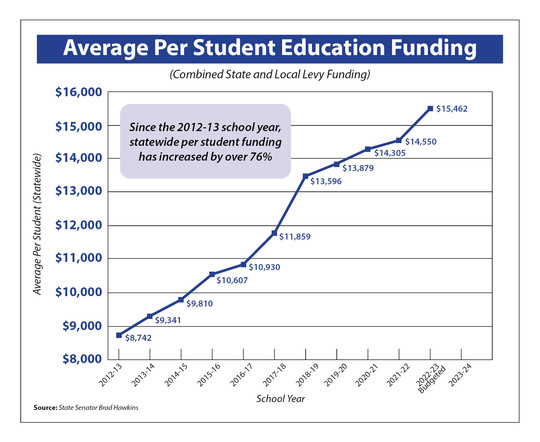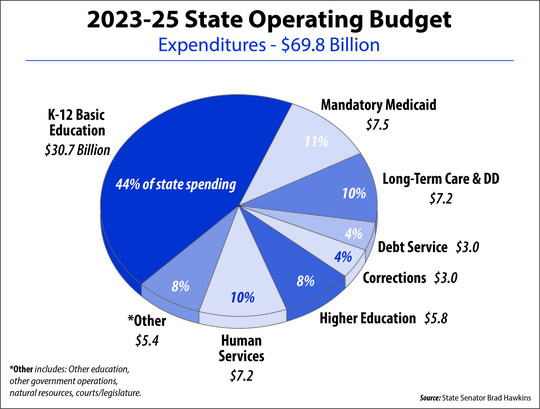|
August 8, 2023
Dear Friends and Neighbors,
As we look ahead to the upcoming school year, I thought I’d take time to provide you with an overview of K-12 school funding. Washington state supports over 1.1 million students in its public schools by providing funding to each school district based on enrollment. Our state Constitution says that education is our paramount duty. What constitutes “full funding” of basic education in Washington has been subject to decades-long debate that eventually resulted in a major lawsuit, known as the McCleary case. As many of you may recall, the Washington State Supreme Court issued its McCleary decision in 2012, which brought significant changes to Washington state school funding
Schools receive local, state, and federal dollars
Our state’s school funding system was already quite complicated prior to the McCleary decision and still remains difficult to understand. Generally speaking, school districts receive state funding based on the total students enrolled in their districts, in accordance with assumed staffing levels. In addition to the state, school districts also receive funding from local and federal sources. Beyond their local, state, and federal funding, school districts can apply for various grants to support expanded services.
As the ranking Republican member on the Senate’s Early Learning and K-12 Education Committee, I work closely on statewide education issues. Prior to being elected to the Legislature, I served for nearly 10 years on the North Central Educational Service District and Eastmont School boards.
School district levies continue to increase
While state and federal funding is allocated in government budgets, local funding to school districts is provided by voters through community-approved property tax levies. For many years, school districts had been using local levy dollars to supplement their state and federal funding, some arguing that increasing levy amounts were necessary due to insufficient state dollars. After the State Supreme Court issued its McCleary decision, the Legislature responded by significantly increasing state funding while implementing strict caps on levy requests to protect property owners. The Legislature later removed the cap on school levies, which I did not support, allowing school districts to request significantly more local funds despite the recent increases in state dollars. As a result, per student funding (in state and local dollars) continues to increase even following the McCleary decision.
While I am a strong supporter of education and acknowledge our state paramount duty, I am concerned about growing property tax burdens on residents and whether school districts can successfully provide the expanded services many districts are now taking on. As a result of changing state policies, increased public expectations, and individual school board decisions, many school districts are now providing a range of meal, childcare, social/emotional support, healthcare, and early learning services in addition to their K-12 academic responsibilities. There is no doubt that many needs exist within our communities and student population, but the question of who should provide these services – and who can provide them most efficiently – is the larger question.
 Per student funding (in state and local dollars) has significantly increased in recent years. On average, school districts received $8,742 per student for the 2012-13 school year and received approximately $15,462 for the 2022-23 school year. Despite increased state funding, school districts continue to seek more and more funding at the local level through their property tax levies.
Expanded services and increasing costs
With services in schools greatly expanding, it is becoming increasingly difficult to differentiate where a school district’s responsibilities end and where a family and community’s responsibilities begin. I believe this to be a fair observation. These school district scope of services changes present challenging dynamics related to education policy, funding obligations, and philosophical debates, including those related to personal responsibility, parental control, and government’s role. As school districts continue to expand the services they provide, it will become more and more difficult to ever “fully fund” education because so many responsibilities are being transitioned into our school system. As the education funding debates and discussions continue, the growing cost of these expanded services is a realization that should be acknowledged. These new services are arguably affecting the state’s ability to fund other services, such as support for student transportation, special education, and academic enrichment. The increased use of local levies to fund the services is creating hardships on property owners and inequities among school districts across the state. Inequity and overuse of school levies was one of the main concerns leading to the 2012 McCleary decision.
Role of local school boards
Since so much focus is directed at the state meeting education funding needs, the important role of school districts is often overshadowed. Despite all the state funding and requirements, Washington state’s 295 school districts are local governments entities, not state agencies. They are governed by their own locally elected boards and administered by school superintendents. School districts collect revenues, develop local priorities, and administer their budgets. They should prudently invest taxpayer dollars (local, state, and federal) to implement programs, negotiate sustainable contracts with employees, and manage operations. In our system, it is the school boards who develop local priorities, approve budgets, and oversee operations for their districts. Despite increasing requirements from the state, they still have significant authority within their districts. As a former school board president, I greatly appreciate their role.
 The operating budget funds the day-to-day operations of the state, including K-12 education. A few years ago, education spending represented 50 percent of the state budget. However, due to spending in other areas and the addition of new state programs, K-12 spending now represents 44 percent of the budget.
Education funding in 2023-2025 budget
As with any budget or major legislation, there are always items to support and opportunities for improvement. With an operating budget that has now grown to $69.8 billion with 44 percent dedicated to K-12 education, this is the case with investments made to our educational system. During the 2023 legislative session, approximately $3 billion was added to education funding beyond the baseline level. Two major bills were approved that constituted the bulk of this additional investment: House Bill 1436 (special education funding) and Senate Bill 5650 (salary inflationary increases). HB 1436 increased special education funding and raised the cap in which school districts could be reimbursed for high-cost special education students. SB 5650 provided a 3.7 percent cost-of-living-adjustment for teachers, exceeding the planned 2.2 percent adjustment. Additional adjustments to the transportation funding formula were also considered.
While these funding changes are certainly needed and appreciated, the 2023-2025 budget spends significantly more on K-12 education without making substantive improvements to address learning loss. Many students are struggling to return to grade level following the COVID pandemic. Junior high teachers I met with recently shared with me that many students are two-to-four years behind grade level in math, leaving the teachers wishing they had elementary math curriculum in their classrooms. For me, getting students to grade level should be the state’s top priority. Students at grade level who previously exceeded their grade level should continue to be challenged as well. The state will otherwise just continue to spend more and more money without achieving different results within the overall system. As a former school board member and supporter of public education, I have been urging this conversation to take place at the highest levels of government.
Thank you for the opportunity to serve you
Hopefully this information is helpful in understanding our state’s complicated educational funding system and the expansion of services either being expected or sought by our school districts. For more detailed information on school funding, please review this Citizen’s Guide to Washington State K-12 Finance. If you have any questions about education or other issues, please feel free to contact my office anytime.
Thank you for the opportunity to serve as your state senator.
Sincerely,
 Brad Hawkins
State Senator Brad Hawkins
12th Legislative District
Website: senatorbradhawkins.org
107 Newhouse Building - P.O. Box 40412 | Olympia, WA 98504-0412
(360) 786-7622 or Toll-free: (800) 562-6000
|